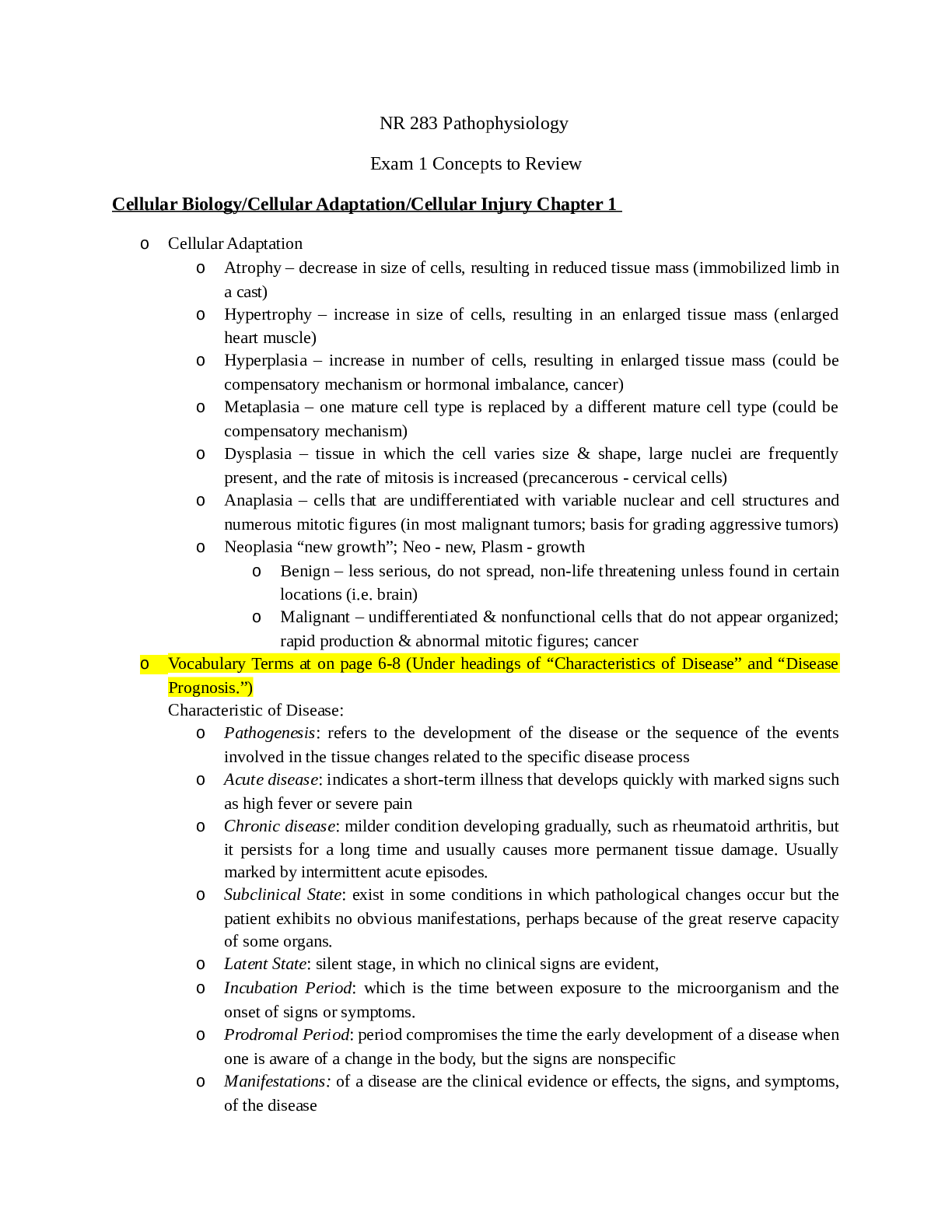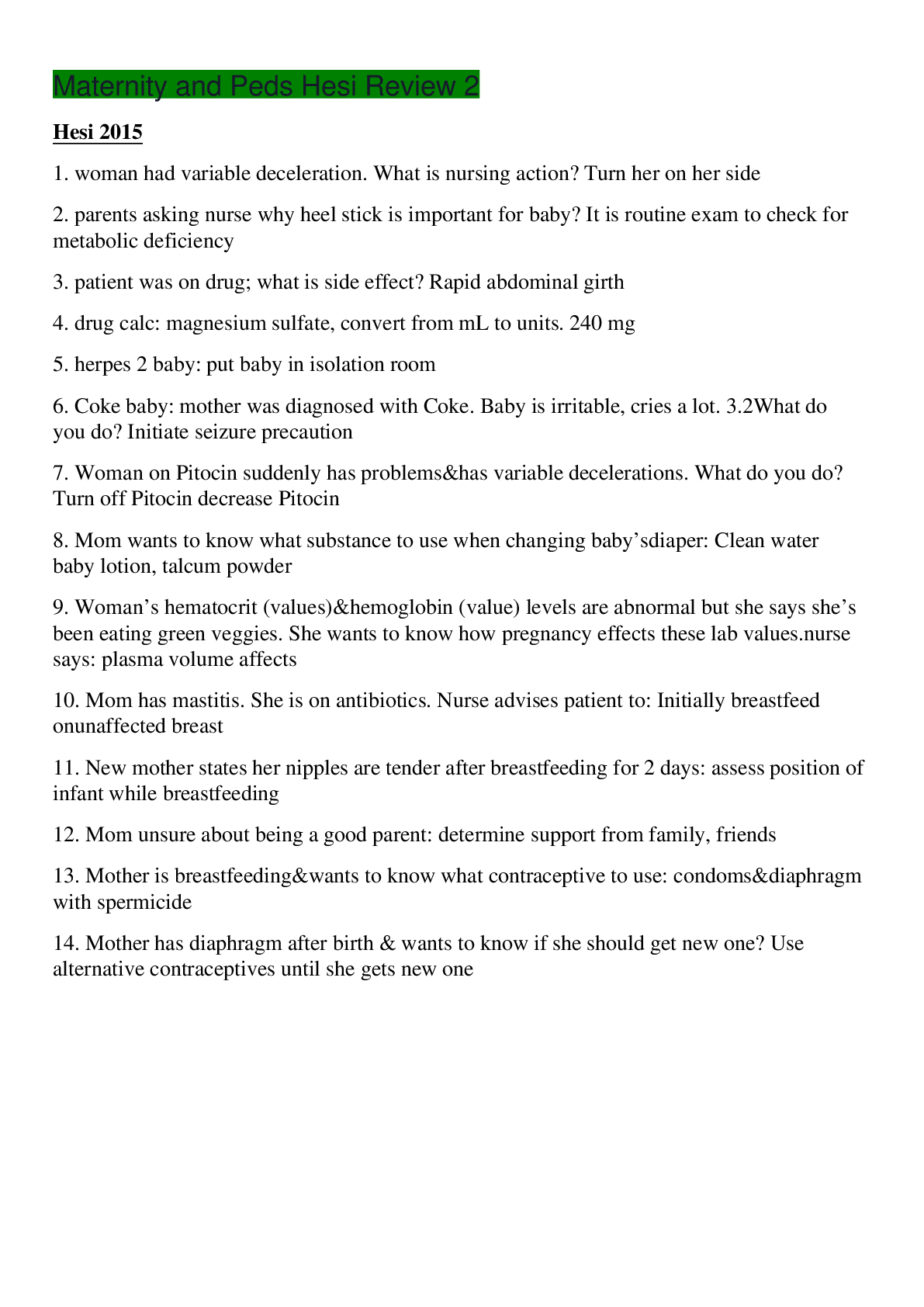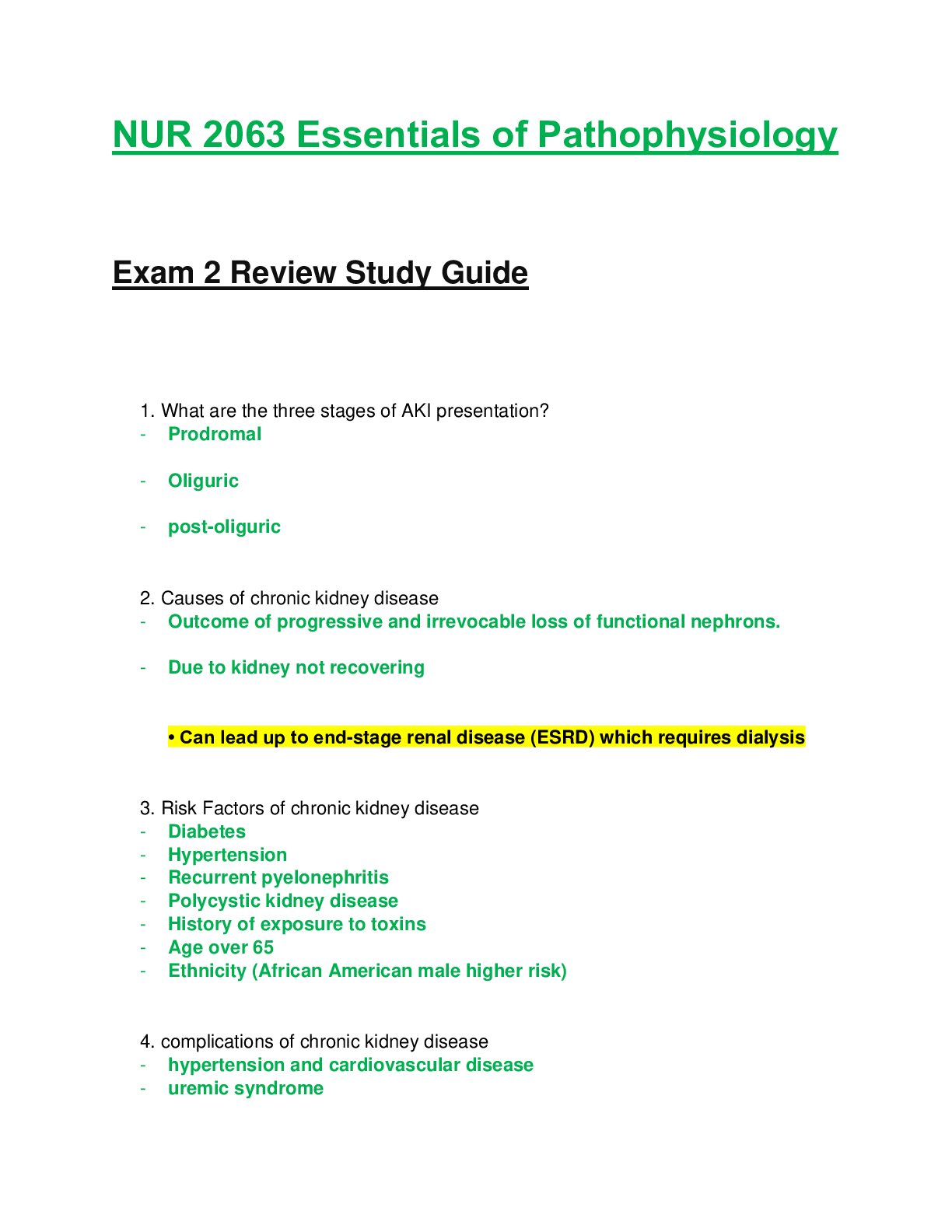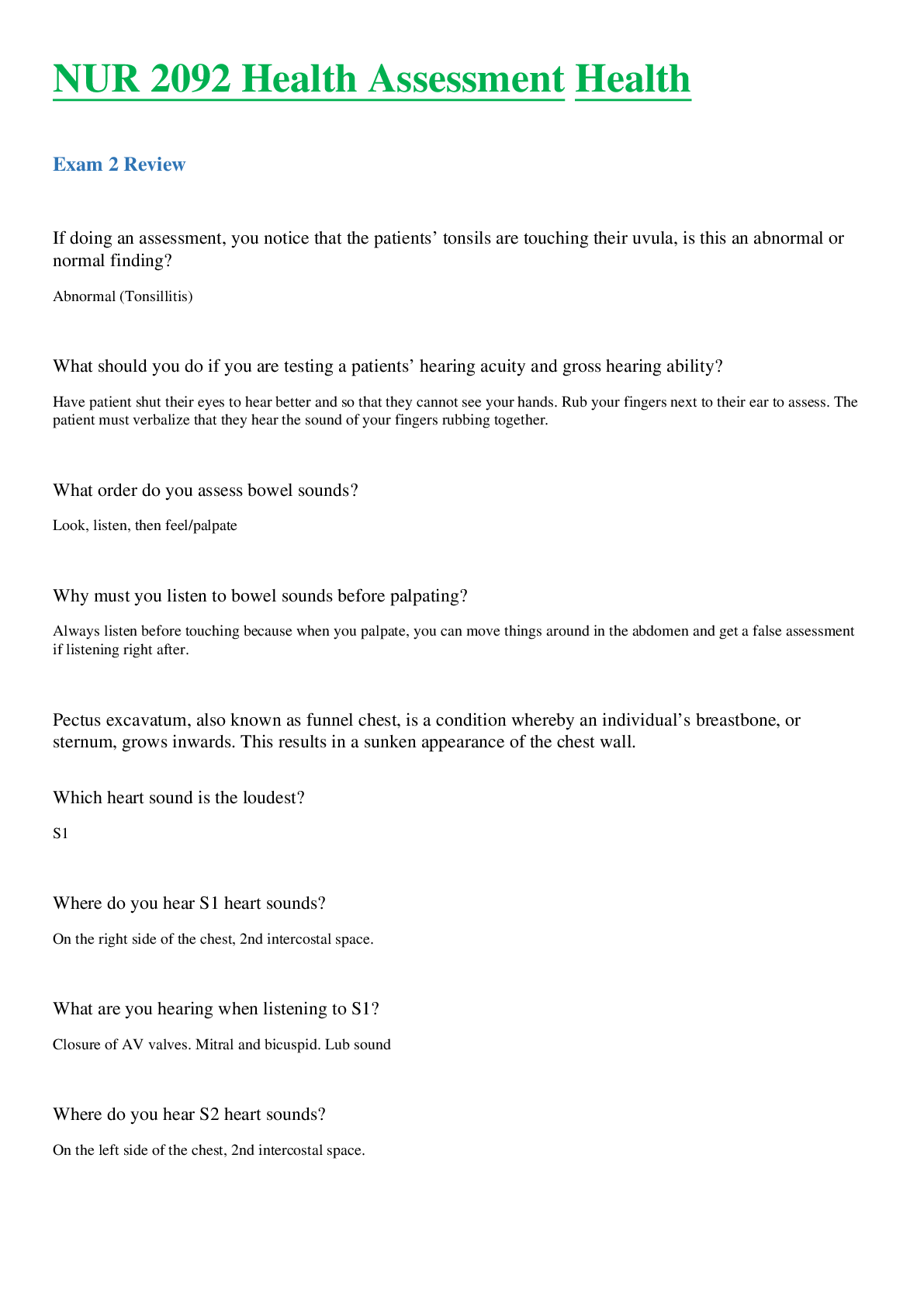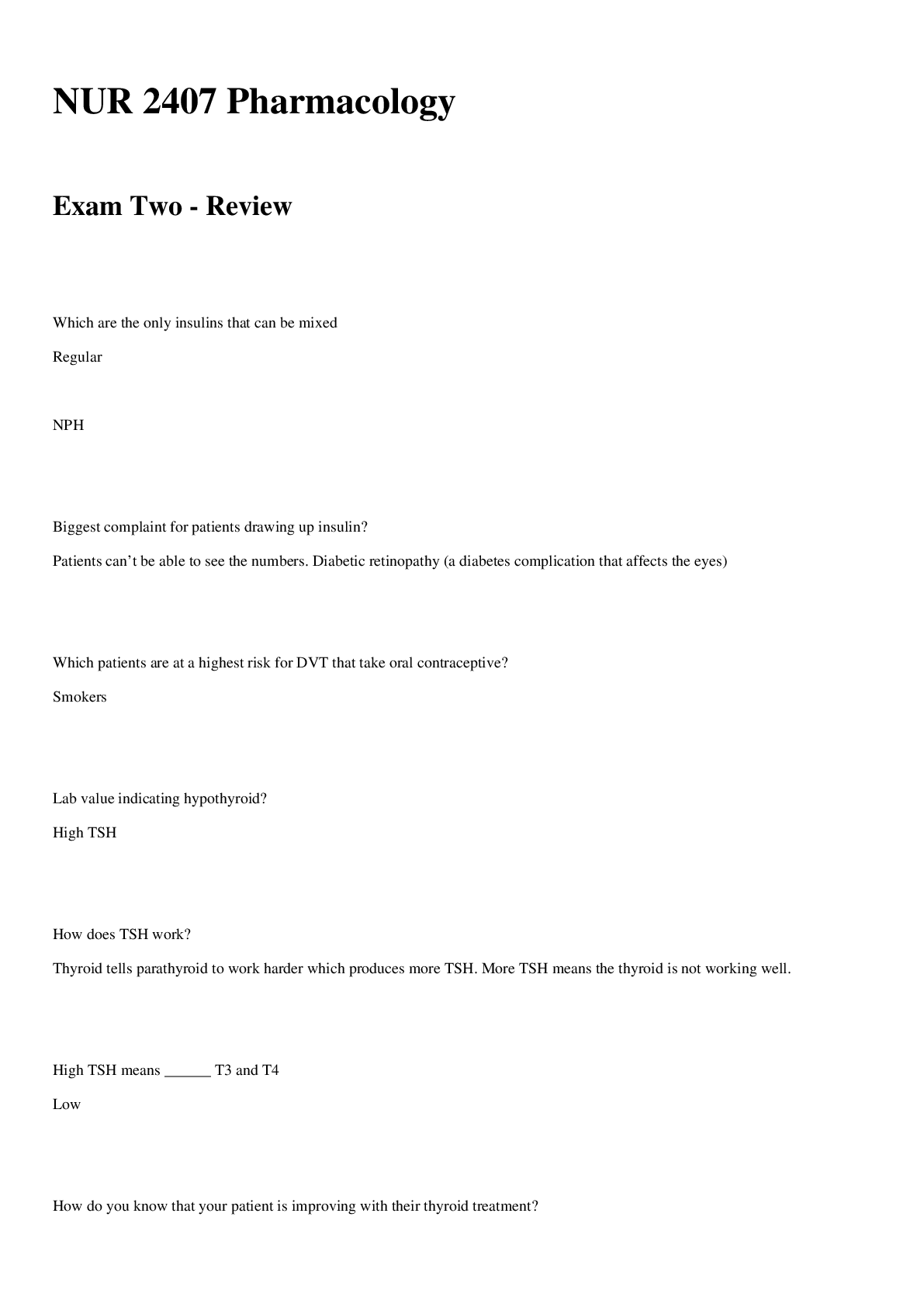Biology > EXAM REVIEW > BIOL 1020-002 Exam 2 Review Latest Updated 2022/2023,100% CORRECT (All)
BIOL 1020-002 Exam 2 Review Latest Updated 2022/2023,100% CORRECT
Document Content and Description Below
BIOL 1020-002 Exam 2 Review Latest Updated 2022/2023 • ALL highlighted, bolded, or underlined Vocabulary words or key terms • ALL specific examples of taxa used to identify key concepts or p... roperties of life • Chapter 6: o Crossover with differences between prokaryotic and eukaryotic cells & the difference between animal and plant cells; what features are present/absent and define the organelles that differ between these cell types ▪ Basic features of all cells: • Plasma membrane • Semifluid substance called cytosol • Chromosomes (carry genes) • Ribosomes (make proteins) ▪ Prokaryotic cells: (bacteria and archaea) • No true nucleus • DNA in an unbound region called the nucleoid • No membrane-bound organelles • Cytoplasm bound by the plasma membrane ▪ Eukaryotic cells: (plants, animals, fungi, and protists) • DNA in a nucleus that is bounded by a double membrane • Membrane-bound organelles • Cytoplasm in the region between the plasma membrane and the nucleus ▪ Plant cells have a singular vacuole that is used for storage and maintaining shape while animal cells have many smaller vacuoles, plant cells also have a cell wall while animal cells do not o What are the major components of the cell membrane; how is surface area important for the membrane to the functions of the cell ▪ Plasma membrane: a selective barrier that allows sufficient passage of oxygen, nutrients, and waste to service the volume of every cell • Only a certain amount of a particular substance can pass through at any given moment • Surface area to volume is critical o What are the major structures of the cell’s cytoskeleton? ▪ Microtubules: hollow rods about 25nm in diameter and about 200 nm to 25 microns long (shape the cell, guide movement of organelles, and separate chromosomes during cell division) ▪ Microfilaments: solid rods about 7nm in diameter, built as a twisted double chain of actin subunits (help support cell shape, form a cortex just inside the plasma membrane) ▪ Intermediate filaments: range in diameter from 8 to 12 nanometers, larger than microfilaments but smaller than microtubules (more permanent cytoskeleton fixtures, support cell shape and fix organelles in place) o Motor proteins; “dynein” ▪ Motor proteins: to produce cell motility ▪ Dynein: has two feet that walk along microtubules, one foot maintains contact while the other releases and reattaches one step farther along o What are examples of specific cell features that are comprised of cytoskeletal components ▪ Microtubules: control the beating of flagella and cilia ▪ Microfilaments: muscle cell contraction ▪ Intermediate filaments: dead skin cells and keratin o What are the differences between the cytoskeletal components; ie. Which of the three cytoskeletal components are the largest? ▪ Ordered from smallest to largest: ▪ Microfilaments ▪ Intermediate filaments ▪ Microtubules o Centrosomes; centrioles; flagella and cilia; how is the cytoskeleton involved in skeletal muscle contraction ▪ Centrosomes: what microtubules grow out from, near the nucleus for cell division ▪ Centrioles: each has nine triplets of microtubules arranged in a ring ▪ Flagella/cilia: microtubule containing extensions that project from some cells ▪ The cytoskeleton is involved in skeletal muscle contraction because it interacts with motor proteins o What is the extracellular matrix (ECM); what makes up the ECM; what are the major roles in cell interactions of the ECM ▪ Extracellular matrix (ECM): since animal cells lack a cell wall it is covered by this • made up of glycoproteins such as collagen, proteoglycans, and fibronectin ▪ Major role: binds to receptor proteins in the plasma membrane called integrins o What are tight junctions; gap junctions; desmosomes ▪ Tight junctions: membranes of neighboring cells are pressed together, preventing leakage of extracellular fluid ▪ Desmosomes: (anchoring junctions) fasten cells together into strong sheets ▪ Gap junctions: (communicating junctions) provide cytoplasmic channels between adjacent cells • Chapter 7: o How does selective permeability function in the plasma membrane? ▪ Selective permeability: allowing some substances to cross the plasma membrane more easily than others o Explain the structures of a phospholipid and how that affects its properties ▪ Phospholipid: the most abundant lipid in the plasma membrane • They are amphipathic molecules, containing hydrophobic and hydrophilic regions • The hydrophobic tails of the phospholipids are sheltered inside the membrane, while the hydrophilic heads are exposed to water on either side o How does the plasma membrane connect to the ECM? ▪ Collagen connects to integrin proteins in the plasma membrane, on the inside of the cell the integrins link up to the microfilaments of the cytoskeleton, on the inner side of the membrane, the integrins are linked to the cytoskeleton. Integrins anchor the cell to the extracellular matrix o What are the components, interactions, etc. of the plasma membrane that make it most like a fluid mosaic model as it is described? ▪ Fluid mosaic model: the membrane is a mosaic of protein molecules bobbing in a fluid bilayer of phospholipids ▪ Proteins are not randomly distributed in the membrane ▪ Constantly moving lipids and proteins and weak hydrophobic interactions keep the plasma membrane so dynamic, fluid like ▪ Membranes are held together mainly by weak hydrophobic interactions ▪ Most of the lipids and some proteins can move sideways within the membrane ▪ Rarely a lipid may flip flop across the membrane, from one phospholipid layer to the other o How does temperature affect the plasma membrane? ▪ Cooling always slows enzymatic/protein activity, especially with increasing saturated fats ▪ As temperatures cool, membranes switch from a fluid state to a solid state ▪ The temperature at which a membrane solidifies depends on the types of lipids ▪ Membranes rich in unsaturated fatty acids are more fluid than those rich in saturated fatty acids o What is the role of cholesterol in the plasma membrane? ▪ Cholesterol helps maintain fluidity of membranes at LOW temperatures by preventing solidification/packing of fatty acids ▪ At warm temperatures cholesterol restrains movement of phospholipids ▪ At cool temperatures, it maintains fluidity by preventing tight packing o What is atherosclerosis ▪ Atherosclerosis: plaque formation o What are the various kinds of proteins found in the plasma membrane? ▪ High density lipoprotein: (good) rids body of excess cholesterol by removing it to liver to be expelled ▪ Low density lipoprotein: (bad) rids cholesterol to your arteries making it likely that plaques will aggregate and cause cardiovascular disease ▪ Peripheral proteins: are bound to the surface of the membrane ▪ Integral proteins: penetrate the hydrophobic core o What are the functions of the plasma membrane for the cell or possible roles it plays in cell-cell communication, etc.; ie. HIV and cell recognition ▪ HIV must bind to the immune cell-surface protein CD4 and a co-receptor CCR5 in order to infect a cell ▪ HIV cannot c=enter the cells of resistant individuals who lack CCR5 ▪ Drugs are now being developed to mask the CCR5 protein ▪ Cells recognize each other by binding to molecules, often containing carbohydrates, on the extracellular surface of the plasma membrane o Glycoproteins vs. glycolipids ▪ Glycolipids: membrane carbohydrates may be covalently bonded to lipids ▪ Glycoproteins: membrane carbohydrates may be covalently bonded to proteins (common) o What molecules most easily pass through the plasma membrane and which molecules need “help” of proteins or transporters ▪ Easily: hydrophobic (nonpolar) molecules such as hydrocarbons can dissolve into the lipid bilayer ▪ Not easy: hydrophilic molecules including ions and polar molecules o What are the different types of transport that molecules have to go through to get across a cell membrane? ▪ Transport proteins: allow passage of hydrophilic substances across the membrane ▪ Channel proteins: have hydrophilic channel that certain molecules or ions can use as a tunnel ▪ Carrier proteins: bind to molecules and change shape to shuttle them across the membrane ▪ Diffusion: the tendency for molecules to spread out evenly into the available space o Facilitated vs. active transport of molecules into a cell ▪ Passive transport: the diffusion of a substance across a biological membrane, no energy is expended by the cell to make it happen ▪ Facilitated transport: energy is expended by the cell to make it happen o Osmoregulation; hypo-, hyer-, and isotonic solutions ▪ Isotonic: solute concentration is the same as that inside the cell; no net water movement across the plasma membrane ▪ Hypertonic: solute concentration is greater than that inside the cell; cell loses water (dehydration) ▪ Hypotonic: solute concentration is less than that inside the cell; cell gains water (bursts or has high pressure with the cell wall) ▪ Osmoregulation: the control of solute concentrations and water balance is a necessary for life in such environments o What is an electrochemical gradient vs. a concentration gradient ▪ Electrochemical gradient: two combined forces that drive the diffusion of ions across a membrane ▪ Concentration gradient: a chemical force o What is exocytosis; what are the different types of endocytosis ▪ Exocytosis: transport vesicles migrate to the membrane, fuse with it, and release their contents outside the cell ▪ Endocytosis: the cell takes in macromolecules by forming vesicles from the plasma membrane • Phagocytosis: the vacuole fuses with a lysosome to digest the particle • Pinocytosis: molecules dissolved in droplets are taken up when extracellular fluid is gulped into tiny vesicles • Receptor-mediated endocytosis: Binding of specific solutes to receptors triggers vesicle formation • Chapter 8: o Be prepared to talk about the Dinoflagellate class example o Big picture what is the point of metabolism and what does that imply ▪ Metabolism: the totality of an organism’s chemical reactions (produces the energy of life) o First and second law of thermodynamics; what is entropy ▪ First law of thermodynamics: the principle for the conservation of energy from one form to another. (Energy can be transferred or transformed, but it cannot be created or destroyed) ▪ Second law of thermodynamics: every energy transfer or transformation increases the entropy (disorder) of the universe ▪ Entropy: is a measure of molecular disorder or randomness o What is free energy; is it positive/negative in exergonic/endergonic reactions ▪ Free energy: is energy that can-do work when temperature and pressure are uniform, as in a living cell o What are some examples of exergonic/endergonic reactions? ▪ Exergonic reaction: proceeds with a net release of free energy and is spontaneous (glucose broken down for cellular respiration) ▪ Endergonic reaction: a reaction in which energy is absorbed o What are bioenergetics ▪ Bioenergetics: the study of how energy flows through living organisms o Catabolic vs. anabolic reactions ▪ Catabolic: release energy by breaking down complex molecules into simpler compounds ▪ Anabolic: consume energy to build complex molecules from simpler ones o What are the different types of energy and how can they be transferrable? ▪ Kinetic: is energy associated with motion ▪ Thermal: is the kinetic energy associated with random movement of atoms or molecules ▪ Potential: is energy that matter possesses because of its chemical reaction ▪ Chemical: is potential energy available for release in a chemical reaction o Is an organism an open or a closed system and why? ▪ Closed: is unable to exchange energy or matter with its surroundings (liquid in a thermos) ▪ Open: energy and matter can be transferred between the system and its surroundings (organisms) o What is the equation for free energy and what do all the components of that equation mean; what is enthalpy o ΔG=ΔH −TΔS ▪ G=the change in free energy ▪ H=change in total energy ▪ S=entropy o How is ATP the cell’s energy shuttle and what does it do at the molecular level ▪ ATP is the cells energy shuttle ▪ ATP is composed of ribosome (a sugar), adenine (a nitrogenous base), and three phosphate groups ▪ The bonds between the phosphate groups of ATP’s tail can be broken by hydrolysis ▪ Energy is released from ATP when the terminal phosphate bond is broken ▪ This release of energy comes from the chemical change to a state of lower free energy, not from the phosphate bonds themselves o Hydrolysis vs. phosphorylation ▪ Hydrolysis: the bonds between the phosphate groups of ATP’s tail can be broken ▪ Phosphorylation: ATP drives endergonic reactions by phosphorylation, transferring a phosphate group to some other molecule, such as a reactant o How is ATP made, what are the components? ▪ ATP is composed of ribose (a sugar), adenine (a nitrogenous base), and three phosphate groups o How do enzymes work in chemical reactions and how do they lower activation energy for a chemical reaction? ▪ In catalysis, enzymes or other catalysts speed up specific reactions by lowering the EA barrier ▪ Enzymes do not affect the change in free energy instead, they hasten reactions that would occur eventually ▪ The reactant that an enzyme acts on is called the enzyme’s substrate ▪ The enzyme binds to its substate, forming an enzyme-substrate complex ▪ While bound, the activity of the enzyme converts substate to product o What are some of the specific variables that enzymes need to optimize to function properly? ▪ Each enzyme has an optimal temperature in which it can function ▪ Each enzyme has an optimal pH in which it can function ▪ Optimal conditions favor the most active shape for the enzyme molecule o Explain an example of a feedback inhibition ▪ Feedback inhibition: the end product of a metabolic pathway shuts down the pathway ▪ Prevents a cell from wasting chemical resources by synthesizing more product than is needed • Chapter 9: o What are the major inputs and outputs of glycolysis/citric acid cycle/ETC? ▪ Citric acid cycle: • Inputs: Glucose, NAD+, ADP+, Pi • Outputs: Pyruvate, NAD+, ADP, and 2 CoA ▪ Glycolysis: • Inputs: 1 glucose • Outputs: 2 pyruvates o What is cellular respiration ▪ Cellular respiration: includes both aerobic and anaerobic respiration but is often used to refer to aerobic respiration ▪ C6H12O6+O6=6CO2+6H2O+Energy o How is cellular respiration the opposite chemical reaction of photosynthesis? ▪ o Aldo Leopold’s point in “Thinking like a mountain” ▪ o What are producers/ consumers and how do they fluctuate in the carbon cycle ▪ Producers: Photosynthetic organisms, namely bacteria, some fungi, and plants (can convert sunlight into a usable food form) ▪ Consumers: organisms unable to convert their own food, so they eat producers to accumulate nutrients o How does catabolism function in cellular respiration to yield energy? ▪ Catabolic pathways: release stored energy by breaking down complex molecules o What is the equation for Cellular respiration? ▪ C6H12O6+O6=6CO2+6H2O+Energy o What is the name of the major enzyme that synthesizes ATP in the ETC; what is chemiosmosis ▪ o Oxidation vs. reduction ▪ Oxidation: a substance loses electrons, or is oxidized ▪ Reduction: a substance gains electron, or is reduced (the amount of positive change is reduced) o Cofactor vs. coenzyme and what does that make NAD+ ▪ Cofactor: a nonprotein helper to a bound to an enzyme reversibly or irreversibly, often inorganic metals such as copper, iron, zinc ▪ Coenzyme: when the cofactor bound to an enzyme is organic, such as many vitamins o How is NADH made—is it oxidized or reduced? ▪ Each NADH represents stored energy that is tapped to synthesis ATP ▪ NADH is the reduced form of NAD+ o Know the major enzymes highlighted and defined for cellular respiration ▪ o What is the final electron acceptor in the electron transport chain? ▪ Passes electrons in a series of steps instead of one explosive reaction ▪ O2 pulls electrons down the chain in an energy-yielding tumble ▪ The energy yielded is used to regenerate ATP o How is pyruvate oxidized to Acetyl CoA? ▪ Each pyruvate molecule loses one carbon atom with the release of carbon dioxide ▪ Electrons are transferred to NAD+ to produce NADH which is used by the cell to produce ATP o What is the difference between substrate-level and oxidative phosphorylation, and which yields most ATP and in which processes of cellular respiration? ▪ Oxidative phosphorylation: the process that generates almost 90% of the ATP because it is powered by redox reactions ▪ Substrate-level phosphorylation: A smaller amount of ATP is formed in glycolysis and the citric acid cycle ▪ Oxidative phosphorylation yields the most ATP o What are the protein complexes called in the ETC? ▪ Cytochromes: Electrons are passed through a number of proteins including these (each with an iron atom) to O2 o What is the “flow” of energy in the cellular respiration processes ▪ Glucose ---> NADH---> electron transport chain ---> proton-motive force > ATP o Approximately how many ATP are made in cellular respiration per one glucose molecule ▪ About 34% of the energy in a glucose molecule is transferred to ATP during cellular respiration, making it about 32 ATP ▪ The rest of the energy is lost as heat o Fermentation and anaerobic respiration ▪ Fermentation: is a partial degradation of sugars that occurs without O2 ▪ Anaerobic: is a type of respiration where oxygen is not used instead, organic or inorganic molecules are used as final electron acceptors o Alcohol vs. lactic acid fermentation and roles in major processes/examples ▪ Alcohol fermentation: pyruvate is converted to ethanol in two steps: • First step: released CO2 from pyruvate • Second step: produces NAD+ and ethanol ▪ By yeast is used in brewing, winemaking, and baking ▪ Lactic acid fermentation: pyruvate is reduced by NADH, forming NAD+ and lactate as end products, with no release of CO2 ▪ By some fungi and bacteria is used to make cheese and yogurt ▪ Human muscle cells use lactic acid fermentation to generate ATP during strenuous exercise when O2 is scarce • Chapter 10: o What is the chemical equation for photosynthesis? ▪ Energy (sunlight) + 6CO2 + 12H2O -- C6H12O6 + 6H2O o Functions/locations/role of chloroplasts in plant cells ▪ Photosynthesis takes place in chloroplasts which contain chlorophyll, they are surrounded by a double membrane and contain a third inner membrane called the thylakoid membrane that forms long folds within the organelle o Autotrophs vs. heterotrophs ▪ Autotrophs: are self-feeders that sustain themselves without eating anything derived from other organisms ▪ Heterotrophs: obtain organic material from other organisms (consumers) o Stomata and the gases involved in photosynthesis/inputs and outputs ▪ CO2 enters and O2 exits the leaf through microscopic pores called stomata ▪ Chloroplasts split H2O into hydrogen and oxygen, incorporating the electrons of hydrogen into sugar molecules and releasing oxygen as a by-product o Is photosynthesis endergonic or exergonic ▪ Photosynthesis is an endergonic process; the energy boost is provided by light o What are the two major parts of photosynthesis? ▪ The light reactions: (in the thylakoids) • Split H2O • Release O2 • Reduce the electron acceptor NADH+ to NADPH • Generate ATP from ADP by photophosphorylation ▪ The Calvin Cycle: (in the stroma) forms sugar from CO2 using ATP and NADPH • The Calvin Cycle begins with carbon fixation, incorporating CO2 into organic molecules o Where do the light reactions take place and at which wavelengths is light optimally absorbed ▪ Light reactions take place in the thylakoids ▪ The absorption spectrum of chlorophyll a suggests the violet-blue and red light work best for photosynthesis (400-500, 650) o What is the electromagnetic spectrum and what are photons? ▪ Electromagnetic spectrum: is the entire range of electromagnetic energy, or radiation ▪ Photons: light also behaves as though it consists of discrete particles called photons o What are the three major photosynthetic pigments? ▪ The three major photosynthetic pigments are violet, blue, and red light o Why are fall leaves many different colors (ie. Other than green) ▪ Fall leaves are many different colors because of carotenoids – a separate group of accessory pigments, produce reds, yellows, and oranges ▪ Chlorophyll: green ▪ Xanthophyll: yellow ▪ Carotene: orange ▪ Anthocyanin: red ▪ Tannins: brown o How does light excite electrons in photosystems and reaction center complexes? ▪ When a pigment absorbs light, it goes from a ground state to an excited state, which is unstable ▪ When excited electrons fall back to the ground state, excess energy is released as heat ▪ Reaction center complexes is an association of proteins holding a special pair of chlorophyll a molecule and a primary electron acceptor o Generally, what are the 8 major steps in the linear flow of electrons in photosynthesis 1. A photon hits a pigment in a light-harvesting complex of PS II, and its energy is passed among pigment molecules until it excites P680 2. An excited electron from P680 is transferred to the primary electron acceptor 3. H2O is split by enzymes, and the electrons are transferred from the hydrogen atoms to P680+, thus reducing it to P680 -P680 is the strongest known biological oxidizing agent – the H+ are released into the thylakoid space - O2 is released as a by-product of this reaction 4. Each electron falls down an electron transport chain from the primary electron acceptor of PS II to PS I. Energy released by the fall drives the creation of a proton gradient across the thylakoid membrane 5. Potential energy stored in the proton gradient drives production of ATP by chemiosmosis 6. IN PS I transferred light energy excites P700, which loses an electron to the primary electron acceptor. P700+ accepts an electron passed down from PS II via the electron transport chain 7. Each electron falls down an electron transport chain from the primary electron acceptor of PS I to the protein ferredoxin 8. NADP+ reductase catalyzes the transfer of electrons to NADP+ reducing it to NADPH. The electrons of NADPH are available for the reactions of the Calvin Cycle. This process also removes an H+ from the stroma o What are the major inputs/outputs of the light reactions/Calvin cycle? ▪ Inputs: carbon enters the cycle as CO2 ▪ Outputs: a sugar named glyceraldehyde 3-phosphate (G3P) o What are the three phases of the Calvin cycle? 1. Carbon fixation (catalyzed by rubisco) 2. Reduction 3. Regeneration of the CO2 acceptor (RuBP) • Chapter 12: o What are the major reasons for cell division? ▪ Development from a fertilized egg ▪ Growth ▪ repair o Mitosis vs. meiosis ▪ Mitosis: is a fundamental process for life, a cell duplicates all of its contents including its chromosomes and splits to form two identical daughter cells ▪ Meiosis: is the type of cell division that creates egg and sperm cells o Asexual vs sexual reproduction ▪ Asexual reproduction: a type of reproduction that does not result in genetic diversity or the change in the number of chromosomes of the daughter cells ▪ Sexual reproduction: the production of new living organisms by combining genetic information from two individuals of different types o Evolution of cell division; binary fission ▪ Binary fission: prokaryotes (bacteria and archaea) reproduce by a type of cell division called binary fission ▪ The chromosome replicates (beginning at the origin of replication) and the two daughter chromosomes actively move apart ▪ Because prokaryotes evolved before eukaryotes, mitosis probably evolved from binary fission o Difference between chromosomes, chromatin, and chromatids ▪ Chromosomes: DNA molecules in a cell are packaged into these ▪ Chromatin: Eukaryotic chromosomes consist of chromatin, a complex of DNA and protein that condenses during cell division ▪ Chromatids: each duplicated chromosome has two sister chromatids (joined copies of the original chromosome) attached along their lengths by cohesions o When does DNA duplication take place; what is interphase and how long does it take place in the cell cycle? ▪ DNA is replicated during the S phase of interphase. Cells spend more of their life in interphase before mitosis occurs o Somatic cells vs gametes and what is the major process that allows for cell division in each cell type ▪ Somatic cells: (nonreproductive cells) have two sets of chromosomes; every other cell in human tissue (22pairs of chromosomes) besides sex cells (gametes) ▪ Gametes: (reproductive cells: sperm and eggs) have half as many chromosomes as somatic cells (1 pair of chromosomes) o What are the major phases of mitosis and what are characteristics of each of the five phases? ▪ Interphase: ▪ G1 and G2 phases are gap phases for intense growth and metabolic activity ▪ S phase: DNA is duplicated ▪ G2: Centrosomes form by duplication and they organize spindles and microtubules ▪ Prophase: sister chromatids condense and join by centrosomes; nucleoli disappears; centrosomes begin to separate ▪ Prometaphase: Microtubules enter the nuclear area; kinetochores form at the centromere of each chromatid ▪ Metaphase: Centrosomes at opposite poles of the cell; chromosomes lined up at cell equator or metaphase plate ▪ Anaphase: Shortest mitotic stage; two sister chromatids separate to become an independent chromosome ▪ Telophase/cytokinesis: two daughter nuclei form and nucleoli reappear; chromosomes become uncondensed; cytokinesis cleaves two daughter cell’s cytoplasm apart o What checkpoint is the most important; what is the G0 phase; how do unchecked dividing cells result in cancer ▪ • Chapter 13: o What are genes and where are they located on a chromosome o What is a karyotype and what are homologous chromosomes? o Autosomes vs. sex cells; haploid vs diploid cells o How does fertilization and meiosis alternate in humans/animals o What are the major steps in Meiosis 1 and 2? o What is crossing over/synapsis and when in meiosis does it occur o How does mitosis and meiosis differ from each other o What are the major mechanisms for genetic variation in meiosis? ***DISCLAIMER: This is BY NO MEANS an exhaustive list for topics to be covered on Exam 2. So, please review ALL slides posted from the end of Chapter 6-Chapter 13 (as designated on Canvas) and recorded lectures/Reading Assignment Quizzes. Textbook and Mastering assignments can be used as supplementary materials to back up materials covered in the lectures for a more thorough understanding. [Show More]
Last updated: 2 years ago
Preview 1 out of 12 pages

Buy this document to get the full access instantly
Instant Download Access after purchase
Buy NowInstant download
We Accept:

Reviews( 0 )
$14.00
Can't find what you want? Try our AI powered Search
Document information
Connected school, study & course
About the document
Uploaded On
Mar 22, 2023
Number of pages
12
Written in
Additional information
This document has been written for:
Uploaded
Mar 22, 2023
Downloads
0
Views
115








